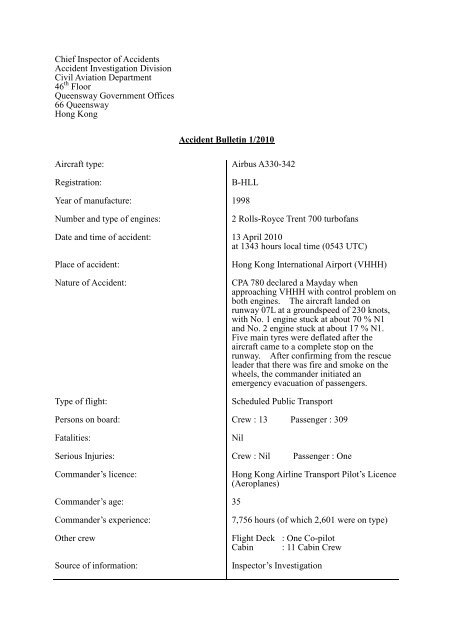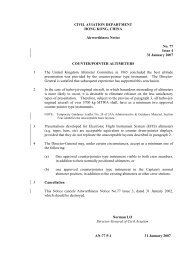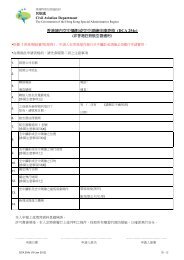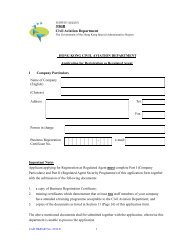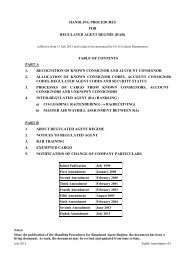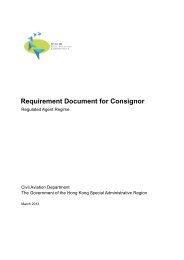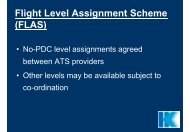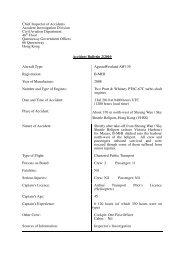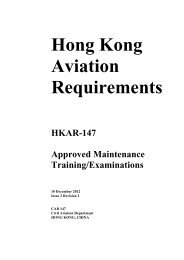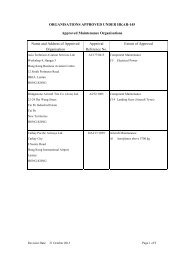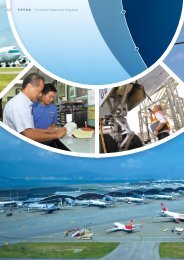Accident Bulletin 1/2010 - Preliminary Report on Airbus A330-342 ...
Accident Bulletin 1/2010 - Preliminary Report on Airbus A330-342 ...
Accident Bulletin 1/2010 - Preliminary Report on Airbus A330-342 ...
- No tags were found...
You also want an ePaper? Increase the reach of your titles
YUMPU automatically turns print PDFs into web optimized ePapers that Google loves.
Chief Inspector of <str<strong>on</strong>g>Accident</str<strong>on</strong>g>s<str<strong>on</strong>g>Accident</str<strong>on</strong>g> Investigati<strong>on</strong> Divisi<strong>on</strong>Civil Aviati<strong>on</strong> Department46 th FloorQueensway Government Offices66 QueenswayH<strong>on</strong>g K<strong>on</strong>g<str<strong>on</strong>g>Accident</str<strong>on</strong>g> <str<strong>on</strong>g>Bulletin</str<strong>on</strong>g> 1/<str<strong>on</strong>g>2010</str<strong>on</strong>g>Aircraft type: <strong>Airbus</strong> <strong>A330</strong>-<strong>342</strong>Registrati<strong>on</strong>:B-HLLYear of manufacture: 1998Number and type of engines:2 Rolls-Royce Trent 700 turbofansDate and time of accident: 13 April <str<strong>on</strong>g>2010</str<strong>on</strong>g>at 1343 hours local time (0543 UTC)Place of accident:Nature of <str<strong>on</strong>g>Accident</str<strong>on</strong>g>:Type of flight:H<strong>on</strong>g K<strong>on</strong>g Internati<strong>on</strong>al Airport (VHHH)CPA 780 declared a Mayday whenapproaching VHHH with c<strong>on</strong>trol problem <strong>on</strong>both engines. The aircraft landed <strong>on</strong>runway 07L at a groundspeed of 230 knots,with No. 1 engine stuck at about 70 % N1and No. 2 engine stuck at about 17 % N1.Five main tyres were deflated after theaircraft came to a complete stop <strong>on</strong> therunway. After c<strong>on</strong>firming from the rescueleader that there was fire and smoke <strong>on</strong> thewheels, the commander initiated anemergency evacuati<strong>on</strong> of passengers.Scheduled Public TransportPers<strong>on</strong>s <strong>on</strong> board: Crew : 13 Passenger : 309Fatalities:NilSerious Injuries: Crew : Nil Passenger : OneCommander’s licence:H<strong>on</strong>g K<strong>on</strong>g Airline Transport Pilot’s Licence(Aeroplanes)Commander’s age: 35Commander’s experience:Other crewSource of informati<strong>on</strong>:7,756 hours (of which 2,601 were <strong>on</strong> type)Flight Deck : One Co-pilotCabin : 11 Cabin CrewInspector’s Investigati<strong>on</strong>
Aircraft <str<strong>on</strong>g>Accident</str<strong>on</strong>g> <strong>on</strong> CPA 780 <strong>on</strong> 13 April <str<strong>on</strong>g>2010</str<strong>on</strong>g>(<strong>Airbus</strong> <strong>A330</strong>-<strong>342</strong> Registrati<strong>on</strong> Mark B-HLL)(All times are in UTC.hours.)Surabaya time is UTC+7 hours and H<strong>on</strong>g K<strong>on</strong>g time is UTC+81. Cathay Pacific Airways (CPA) flight number CPA 780 was scheduled to operate fromthe Juanda Internati<strong>on</strong>al Airport (WARR), Surabaya, Ind<strong>on</strong>esia to the H<strong>on</strong>g K<strong>on</strong>gInternati<strong>on</strong>al Airport (VHHH) <strong>on</strong> 13 April <str<strong>on</strong>g>2010</str<strong>on</strong>g> with a scheduled time of departure(STD) at 0120 hours (hr) and scheduled time of arrival (STA) at 0600 hr. The actualand forecast weather al<strong>on</strong>g the flight plan route, including the departure and arrivalairports, were c<strong>on</strong>sidered acceptable by the flight crew. There was no enginesystem-related or fuel system-related defect reported in the maintenance log of theaircraft prior to departure. The actual Take Off Weight (TOW) was around 198,700kilograms (kg), with a total of 33,400 kg of Jet A-1 fuel, including 24,400 kg of fueluplifted at stand number 8 at WARR where the aircraft was parked before departure.2. The aircraft took off from runway 28 at 0124 hr. The departure was uneventful andwas away from any significant weather. During the climb, the flight crew noticedsome minor Engine Pressure Ratio (EPR) fluctuati<strong>on</strong>s <strong>on</strong> No. 2 engine. No. 1 enginealso had EPR fluctuati<strong>on</strong>s but within a narrower range.3. At 0158 hr, when the aircraft was leveling off at Flight Level (FL) 390 (i.e. 39,000 feetabove mean sea level at standard atmosphere), the Electr<strong>on</strong>ic Centralised AircraftM<strong>on</strong>itoring (ECAM) message “ENG 2 CTL SYS FAULT” was annunciated. Theflight crew followed the ECAM procedures. They also c<strong>on</strong>tacted the “MaintenanceC<strong>on</strong>trol” (MC) of the CPA Engineering Department for technical advice. Thecompany’s Operati<strong>on</strong>s Manuals were reviewed. As parameters <strong>on</strong> both engines werenormal except the slight fluctuati<strong>on</strong> of the EPR indicati<strong>on</strong>s, both the flight crew and theMC were satisfied that it was safe for the flight to c<strong>on</strong>tinue.4. At 0316 hr, ECAM message “ENG 2 CTL SYS FAULT” reappeared. CPA 780c<strong>on</strong>tacted MC to discuss and review the issue again. As all engines parametersremained normal except the EPR fluctuati<strong>on</strong>s, both the flight crew and the MC weresatisfied that it was safe for the flight to c<strong>on</strong>tinue to VHHH.
9. The commander flew the aircraft manually for a visual approach for runway 07L. At0541 hr, ATC cleared CPA 780 to land with the reported wind of 150 degrees at 13knots. During the final approach with both thrust levers at the idle positi<strong>on</strong>, No. 1engine was stuck at about 74 % N1, and decreased to about 70 % N1 during touchdown,and No. 2 engine was stuck at about 17 % N1 throughout the approach and landing.10. CPA 780 landed <strong>on</strong> runway 07L at 0543 hr at a ground speed of 230 knots with alanding weight of approximately 173,600 kg. On landing, the lower cowling of No. 1engine c<strong>on</strong>tacted the runway surface briefly. Spoilers were deployed automatically.Only No. 1 engine thrust reverser deployed. The commander applied maximummanual braking and the aircraft came to a complete stop <strong>on</strong> the runway. The No. 1engine was still running at 76 – 79 % N1 with the No. 1 thrust lever at idle. The flightcrew shut down both engines. The aircraft had five main tyres deflated.11. The AFC appliances arrived <strong>on</strong> scene in <strong>on</strong>e minute after the aircraft came to acomplete stop. The AFC assessed the situati<strong>on</strong> and noted that there was fire andsmoke <strong>on</strong> the main wheels. They sprayed water to extinguish the fire.12. After c<strong>on</strong>firming from the AFC rescue leader that there was fire and smoke <strong>on</strong> thewheels, the commander initiated an emergency evacuati<strong>on</strong> of passengers. The cabincrew then opened all eight emergency exits and the associated slides were deployedautomatically. All passengers were able to leave the aircraft in about two minutes.The flight crew carried out a final check of the whole cabin to ensure all the passengersand the cabin crew had evacuated before leaving the aircraft. During the evacuati<strong>on</strong>,57 passengers were injured. Most of them sustained minor injuries and were givenmedical treatment immediately at the airport. Ten of them were sent to the hospitalsfor medical treatment with <strong>on</strong>e passenger suffered from b<strong>on</strong>e fracture and ankle jointdislocati<strong>on</strong>.13. The Chief Inspector of <str<strong>on</strong>g>Accident</str<strong>on</strong>g>s has ordered an Inspector’s Investigati<strong>on</strong> into thecircumstances and the cause of the accident in accordance with the H<strong>on</strong>g K<strong>on</strong>g CivilAviati<strong>on</strong> (Investigati<strong>on</strong> of <str<strong>on</strong>g>Accident</str<strong>on</strong>g>s) Regulati<strong>on</strong>s (Laws of H<strong>on</strong>g K<strong>on</strong>g, Chapter 448B).The investigati<strong>on</strong> is being c<strong>on</strong>ducted by an investigati<strong>on</strong> team c<strong>on</strong>sisting ofinvestigators from the H<strong>on</strong>g K<strong>on</strong>g Civil Aviati<strong>on</strong> Department, the Bureau d’Enquêtes etd’Analyses pour la sécurité de l’aviati<strong>on</strong> civile (BEA) of France and the Air <str<strong>on</strong>g>Accident</str<strong>on</strong>g>sInvestigati<strong>on</strong> Branch (AAIB) of the United Kingdom. The Nati<strong>on</strong>al Transportati<strong>on</strong>Safety Committee (NTSC) of Ind<strong>on</strong>esia and the Nati<strong>on</strong>al Transport Safety Board(NTSB) of the United States of America also provide assistance in the investigati<strong>on</strong>.Experts from <strong>Airbus</strong>, Rolls Royce and CPA also assist in the investigati<strong>on</strong>.
14. The accident investigati<strong>on</strong> team has c<strong>on</strong>ducted interviews with the commander, theco-pilot, the cabin crew, and some of the passengers <strong>on</strong> CPA 780. The informati<strong>on</strong> ofthe Digital Flight Data Recorder (DFDR), Cockpit Voice Recorder (CVR), QuickAccess Recorder (QAR) have been successfully downloaded for analysis. The aircraftflight documents, maintenance records, weather informati<strong>on</strong>, ATC radio and radarrecordings, fuel samples from the subject aircraft and the departure airport have alsobeen collected for investigati<strong>on</strong> purposes. The engines, their c<strong>on</strong>trol systems and thefuel system are under detailed examinati<strong>on</strong>s to determine the possible causes of theabnormal engines behaviours. Engine fuel comp<strong>on</strong>ents and the fuel samples collectedhave been sent to the United Kingdom and the United States of America for test andanalysis.15. Based <strong>on</strong> past experience, the investigati<strong>on</strong> is expected to take more than <strong>on</strong>e year tocomplete. However, during the course of the investigati<strong>on</strong>, should any safetyrecommendati<strong>on</strong> be necessary, it will be promulgated immediately.This <str<strong>on</strong>g>Bulletin</str<strong>on</strong>g> c<strong>on</strong>tains facts relating to the accident as determined up the time of issue. Theinformati<strong>on</strong> must be regarded as tentative and subject to alterati<strong>on</strong> or correcti<strong>on</strong> if additi<strong>on</strong>alevidence becomes available.


